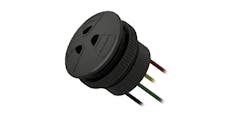Sound Off: Unique Alarm Takes Over All Systems
The dreadful noise of your alarm in the morning is custom-designed to make your eyes jolt open. It’s that distinct beep that you know (and dread) so well that lets you know it’s time to get up and get moving. However, you don’t hear that same beep from any other alarm—your microwave alert is different from your alarm clock, which is different from your stove timer, which is different from your smoke detector, and so on.
This is all part of a sound design that helps you instinctively and immediately know what to look for when you hear an alarm and what actions to take.
This same concept holds true in the plant. Many companies offer alarms for the facility to alert workers to a variety of problems, each with their own custom sounds, tones, and patterns. Which means you usually need multiple alarms for each system or machine. That’s where the CAN Alarm from Floyd Bell comes into play.
This system promises to take on the full alarming needs for an entire facility while offering a customizable sound for each system or machine it contains. We spoke with Gary Zimmerman of Floyd Bell to find out exactly how it works.
NED: What is the CAN Alarm and what industry/workers will use it?
GARY ZIMMERMAN (GZ): The CAN Alarm is a panel mount Piezo Alarm that operates on any system using the CAN J1939 protocol. While the automotive and work vehicle industries have been some of the first to adopt CAN technology, it’s being used in applications ranging from marine vehicles to car washes. All of these industries need their equipment to communicate audible information to the user. Rather than wiring separate multiple alarm components, each with its own dedicated power, the CAN alarm provides one single device on the existing wiring network to emit multiple sounds/tones/patterns to communicate multiple alerts and alarm conditions.
NED: What are the main features?
GZ: The alarm offers a huge output—it’s the lowest frequency and loudest piezo alarm we manufacture, and it is arbitrary address capable. Users can configure a unique sound for each alarm condition along with being able to digitally control the volume emitted.
NED: What is your favorite feature and why?
GZ: The most impressive part of the CAN Alarm is that it basically takes our entire catalog of more than 1,000 different audible devices and puts them all into one unit that can be configured and controlled with a communications system that’s already in place. The possibilities are endless, so theoretically, every application will use a different combination of tones. It’s also worth mentioning that our engineers designed it to be a lower frequency than our other alarms, which helps it perform better in ambient noise environments. You should be able to hear this alarm over just about any work environment.
NED: How is this alarm different than similar products on the market?
GZ: We haven’t found anything quite like the CAN Alarm on the market. While several manufacturers have taken a stab at providing an audible with CAN connectivity, none of them offer the robust set of features, rugged durability, and output of our component.
NED: When was it developed and what specific manufacturing challenges is it meant to solve?
GZ: Our engineers have been developing the CAN Alarm for more than a year, but we officially released the product in the summer of 2019. The CAN alarm solves several problems. If you have different alarm conditions on your equipment, those need to be assigned different types of tones. Think about the sounds in your car. When a door is open, that should make a completely different sound than if your gas tank is empty. We want to make it as easy as possible to communicate in detail to the user of the equipment and now an endless combination of sounds and tones can be assigned to different input signals—all using a single device. Previously, this would require multiple alarms. Using the existing CANbus, we’re able to just add this unit to an existing J1939 system, allowing the alarm to be configured for whatever messages it receives via the network rather than being “pre-canned” with specific sounds.
NED: What was the biggest challenge in making this?
GZ: Our biggest challenge in developing this component was making something that was simple to use but complicated enough to meet the needs of a wide variety of sounding applications. The range of applications of our audible products is quite large, and we wanted this single CAN Alarm to be able to be a “one-size-fits-all” component, letting our customers decide how they’d like to configure their sounds based on their unique alarm conditions.
